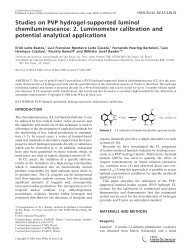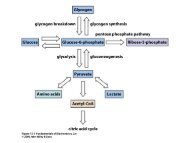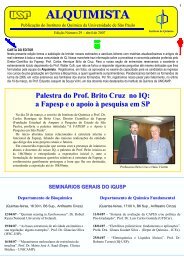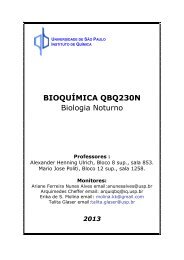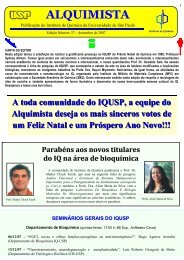<strong>The</strong> trans A/B stereochemistry <strong>of</strong> the abietic and pimaricacids was established 46 by examining the pK values <strong>of</strong> thecarboxylic acids 37 derived by oxidative degradation. <strong>The</strong>seresults were then extended to the triterpenes. <strong>The</strong> results <strong>of</strong>stereochemical studies in the terpene and steroid series providedmany <strong>of</strong> the examples on which the theories <strong>of</strong> the con<strong>for</strong>mationalanalysis <strong>of</strong> reactions were based.<strong>The</strong> con<strong>for</strong>mational stability <strong>of</strong> trans fused α-decalones wasused to establish the B/C trans configuration in the pentacyclictriterpenes 79 and to establish the trans A/B fusion in thedi<strong>terpenoid</strong>s such as marrubiin 61. 80 An interesting summary<strong>of</strong> the application <strong>of</strong> these reactions to the stereochemistry <strong>of</strong>the eudesmane group <strong>of</strong> sesquiterpenes appeared in 1960. 81<strong>The</strong> strategy <strong>of</strong> using cyclization reactions such as lactonizationreactions to establish the cis stereochemistry <strong>of</strong> the D/Ering junction in the pentacyclic triterpenes, in which the facile<strong>for</strong>mation <strong>of</strong> the lactone 62 could only be accommodated withcis ring junction, is an example. 79,82<strong>The</strong> elucidation <strong>of</strong> the cyclization reactions <strong>of</strong> santonin togive the bridged santonic acid 63 played an interesting rolein establishing the stereochemistry <strong>of</strong> santonin. 83 Howeverthe correct configuration at C-11 was eventually establishedby X-ray analyses <strong>of</strong> 2-bromo-α-santonin and 2-bromo-βsantonin.84which was related to ()-citronellal, established 88 the absolutestereochemistry <strong>of</strong> the steroids at C-20.<strong>The</strong> extension <strong>of</strong> the method <strong>of</strong> molecular rotation differences,which had been successfully applied to correlations <strong>of</strong>stereochemistry in the steroid series, to similar changes in thetriterpenes 89 and then to the sesqui- and diterpenes, 90 provideduseful correlations <strong>of</strong> absolute stereochemistry.13 Optical rotatory dispersion and circular dichroism<strong>The</strong> closely related methods <strong>of</strong> optical rotatory dispersion andcircular dichroism played an important role in establishingthe absolute stereochemistry <strong>of</strong> <strong>terpenoid</strong> natural products. 91Although some <strong>of</strong> the first observations <strong>of</strong> the change <strong>of</strong>optical rotation with wavelength were made with camphor, theprincipal applications to stereochemistry did not begin untilthe 1950’s with the work <strong>of</strong> Djerassi and Klyne. <strong>The</strong> octantrule, <strong>for</strong> predicting the sign <strong>of</strong> the Cotton effect in the ORDcurve <strong>of</strong> ketones in a chiral environment, was based on theposition <strong>of</strong> substituents adjacent to the ketone. 92 This <strong>development</strong>meant that it was possible to assign the absolute stereochemistryto a number <strong>of</strong> <strong>terpenoid</strong>s. A particular impact<strong>of</strong> these studies was the demonstration that a number <strong>of</strong>di<strong>terpenoid</strong>s belonged to the antipodal series, i.e. their absolutestereochemistry at the A/B ring junction was opposite to that <strong>of</strong>the steroids and other di<strong>terpenoid</strong>s such as abietic acid. Forexample the di<strong>terpenoid</strong> cafestol 65 was converted into theethylketone 66. 93 <strong>The</strong> ORD curve <strong>of</strong> this ketone was the mirrorimage <strong>of</strong> the curve from 4α-ethylcholestan-3-one and hence theabsolute stereochemistry <strong>of</strong> the A/B ring junction <strong>of</strong> cafestol isopposite to that <strong>of</strong> the steroids. Studies on the ring D ketones<strong>of</strong> a number <strong>of</strong> di<strong>terpenoid</strong>s were important in establishingtheir absolute stereochemistry. 76,9412 <strong>The</strong> <strong>determination</strong> <strong>of</strong> absolute stereochemistryA number <strong>of</strong> monoterpenes were known to occur in both enantiomeric<strong>for</strong>ms. Optically active methylsuccinic and β-methyladipicacids had been obtained as degradation products andthese were correlated with D-()-glyceraldehyde. Other interrelationshipsbetween the mono<strong>terpenoid</strong>s provided usefulstereochemical correlations. 85 Hence when the absolute stereochemistry<strong>of</strong> sodium rubidium tartrate was established byX-ray crystallography and the correlation made with D-()-glyceraldehyde, 86 the absolute stereochemistry <strong>of</strong> many <strong>of</strong> themonoterpenes was established.Synthetic interrelationships between carvone and the sesquiterpenes<strong>of</strong> the eudesmane series and between eudesmol andthe steroid series led to a correlation <strong>of</strong> their absolute stereochemistry.87 An important degradation <strong>of</strong> cholest-14-en-3β-olto give a fragment 64 containing the steroid side chain and14 <strong>The</strong> absolute stereochemistry <strong>of</strong> <strong>terpenoid</strong> secondaryalcoholsA number <strong>of</strong> methods have been developed <strong>for</strong> establishing theabsolute stereochemistry <strong>of</strong> a secondary alcohol. Studies on theaddition <strong>of</strong> Grignard reagents to the α-keto-esters <strong>of</strong> opticallyactive <strong>terpenoid</strong> alcohols showed 95 that asymmetric inductioncould be used to establish the stereochemistry <strong>of</strong> a chiralalcohol. <strong>The</strong> chirality <strong>of</strong> the atrolactic acid that was <strong>for</strong>medreflected that <strong>of</strong> the original secondary alcohol. Horeau’smethod 96 was based on the kinetic resolution by the alcohol inits esterification by 2-phenylbutyric anhydride. <strong>The</strong> method isbased on using a racemic mixture <strong>of</strong> the anhydride. Oneenantiomer will react faster with the chiral secondary alcoholthan the other. <strong>The</strong> optical activity <strong>of</strong> the remaining 2-phenylbutyricacid will thus reflect the chirality <strong>of</strong> the secondaryalcohol.An NMR method based on derivatization with (R)- and (S)-α-methoxy-α-trifluoromethylphenylacetic acid (MTPA) hasbecome a popular strategy <strong>for</strong> establishing the absolute stereochemistry<strong>of</strong> <strong>terpenoid</strong> alcohols. 97 Although it was originallybased on an analysis <strong>of</strong> the 19 F NMR spectrum, a more reliable612 Nat. Prod. Rep., 2001, 18, 607–617
version uses the high field 1 H NMR spectrum. A correlationwas established between the absolute stereochemistry <strong>of</strong> <strong>terpenoid</strong>secondary alcohols and the ∆δ (δ S δ R ) values <strong>of</strong> adjacentprotons <strong>for</strong> the (R)- and (S)-MPTA esters. This correlation wassuccessfully applied in establishing the absolute stereochemistry<strong>of</strong> a number <strong>of</strong> marine <strong>terpenoid</strong>s <strong>of</strong> the cembranolide andxenicane series. 98In a few instances the absolute configuration <strong>of</strong> a <strong>terpenoid</strong>has been determined by X-ray crystallography <strong>of</strong> a heavy atomderivative, e.g. an ester or an amide containing a bromine atom.<strong>The</strong> assumption is <strong>of</strong>ten made that all <strong>of</strong> a group <strong>of</strong> terpenesthat occur in a particular plant belong to the same enantiomericseries. However there have been a number <strong>of</strong> reports where,<strong>for</strong> example, enantiomeric labdane diterpenes co-occur in thewood <strong>of</strong> Oxystigma oxyphyllum 99 and in the leaves <strong>of</strong> Mimosahostilis. 100 Hence this assumption in <strong>terpenoid</strong> <strong>structure</strong>elucidaton is not always valid.15 <strong>The</strong> transition to spectroscopy driven <strong>strategies</strong><strong>The</strong> elucidation <strong>of</strong> the <strong>structure</strong> <strong>of</strong> gibberellic acid 54 representsthe transition between the <strong>strategies</strong> that were dominated bychemical degradation and those that were driven by the use <strong>of</strong>physical methods. <strong>The</strong> work in the 1950’s concentrated onestablishing the <strong>structure</strong> <strong>of</strong> the acid-catalysed degradation andrearrangement products, allogibberic 67 and gibberic 68 acids. 73<strong>The</strong>se studies utilized classical dehydrogenation reactions t<strong>of</strong>orm substituted fluorenes which were then synthesized, andsecondly stepwise degradative sequences in which rings C andD were cleaved. 101 This chemical work was supplemented byin<strong>for</strong>mation drawn from ultraviolet and infrared spectroscopy.However several aspects <strong>of</strong> the <strong>structure</strong> <strong>of</strong> gibberellic aciditself which were described in 1958, utilized assignments <strong>of</strong> the1 H NMR spectrum. 102 <strong>The</strong> full <strong>structure</strong> and stereochemistrywas based on a combination <strong>of</strong> chemical and spectroscopicstudies in which 1 H NMR spectroscopy played an importantrole in interrelating protons, <strong>for</strong> example the trans relationshipbetween H-5 and H-6. 103 Independent X-ray crystallographicstudies <strong>of</strong> heavy atom derivatives were also published.104 More recent studies on the <strong>structure</strong>s <strong>of</strong> novelgibberellins are entirely determined by physical methods,particularly mass spectrometry. 105Spectroscopic methods played a significant role in the finalelucidation <strong>of</strong> the <strong>structure</strong>s <strong>of</strong> a number <strong>of</strong> highly oxygenated<strong>terpenoid</strong> bitter principles including clerodin 69 106 andlimonin 70. 107 In these cases prior chemical work had establishedpartial <strong>structure</strong>s but the evidence <strong>for</strong> the full <strong>structure</strong>hinged on the ability <strong>of</strong> 1 H NMR spectroscopy to link groups<strong>of</strong> atoms. In the sesquiterpene area the elucidation and revision<strong>of</strong> the <strong>structure</strong> <strong>of</strong> the trichothecenes (e.g. 71) 108 revealedthe ability <strong>of</strong> 1 H NMR spin decoupling studies to cope withhighly oxygenated compounds, thus avoiding the need <strong>for</strong>the stepwise removal <strong>of</strong> functional groups and the structuralsimplification which characterized the earlier chemicallydriven <strong>strategies</strong>.<strong>The</strong> increasing role <strong>of</strong> X-ray crystallography in <strong>structure</strong><strong>determination</strong> was also illustrated at this time. A number <strong>of</strong><strong>structure</strong>s, such as those <strong>of</strong> clerodin 109 and limonin, 110 were alsodetermined by crystallographic methods in ‘competition’ withthe classical chemical and spectroscopic studies. Although thetheory <strong>of</strong> non-heavy atom <strong>structure</strong> <strong>determination</strong> was known,the majority <strong>of</strong> the <strong>terpenoid</strong> <strong>structure</strong>s that were reported inthe 1960’s were based on heavy atom derivatives. One <strong>of</strong> theearliest <strong>terpenoid</strong> non-heavy atom <strong>structure</strong>s to be reported 111was that <strong>of</strong> rosein III (11β-hydroxyrosenonolactone) 72 in1970.16 <strong>The</strong> impact <strong>of</strong> instrumental chromatographic techniques<strong>The</strong> <strong>development</strong> <strong>of</strong> instrumental chromatographic techniques<strong>for</strong> the separation <strong>of</strong> natural products, particularly <strong>terpenoid</strong>s,had widespread ramifications in <strong>structure</strong> elucidation. 112 <strong>The</strong>gas chromatographic analysis <strong>of</strong> essential oils had revealedtheir complexity and when coupled with mass spectrometry ledto the elucidation <strong>of</strong> the <strong>structure</strong>s <strong>of</strong> a number <strong>of</strong> new monoandsesqui<strong>terpenoid</strong>s. <strong>The</strong> understanding <strong>of</strong> factors whichaffect the fragmentation patterns <strong>of</strong> <strong>terpenoid</strong>s in the massspectrometer and the use <strong>of</strong> these as structural tools hasbecome very important. <strong>The</strong> sensitivity <strong>of</strong> the methods gave astimulus to insect chemistry in which a number <strong>of</strong> volatilemono- and sesqui<strong>terpenoid</strong>s play an important role as pheromones.113 <strong>The</strong> conversion <strong>of</strong> the gibberellin plant hormones totheir esters and trimethylsilyl ethers followed by their separationand identification by gas chromatography–mass spectrometryled not only to the elucidation <strong>of</strong> the <strong>structure</strong>s <strong>of</strong>over 120 <strong>of</strong> these compounds but also to their quantitation atvarious stages <strong>of</strong> plant <strong>development</strong>. 105,114 Confirmatory syntheticand model studies have become a very important part <strong>of</strong>these instrumental <strong>strategies</strong> in which very small amounts <strong>of</strong>the natural product are examined.<strong>The</strong> <strong>development</strong> <strong>of</strong> HPLC as a separation tool and the linkwith spectroscopic methods has had a similar impact on theisolation and <strong>structure</strong> elucidation <strong>of</strong> more polar <strong>terpenoid</strong>natural products, particularly compounds from marine sources.17 <strong>The</strong> impact <strong>of</strong> biosynthetic studies<strong>The</strong> <strong>development</strong> <strong>of</strong> plausible biogenetic schemes based on theisoprene rule, the cyclization <strong>of</strong> polyprenyl chains and therearrangement <strong>of</strong> carbocationic intermediates, provided themeans <strong>of</strong> evaluating <strong>terpenoid</strong> <strong>structure</strong>s. 115 <strong>The</strong> discovery <strong>of</strong>the role <strong>of</strong> mevalonic acid in the biosynthesis <strong>of</strong> cholesterol 116and the subsequent demonstration <strong>of</strong> its incorporationin vivo into <strong>terpenoid</strong> fungal metabolites led 117 to studies whichchanged this biogenetic speculation into biosynthetic evidence.Studies in <strong>terpenoid</strong> biosynthesis may be divided into fourphases. <strong>The</strong> first phase involves the origin <strong>of</strong> the isoprene unit,Nat. Prod. Rep., 2001, 18, 607–617 613


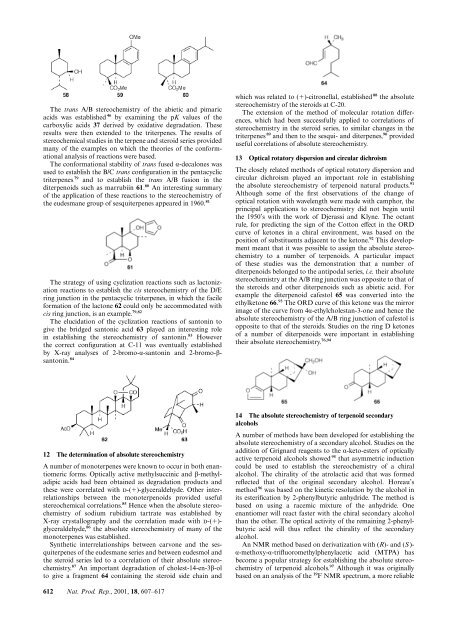
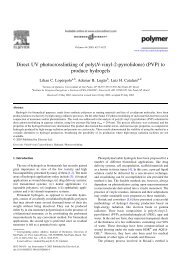
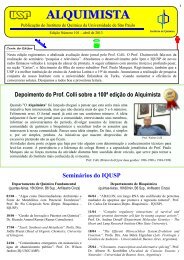
![PE]+ + N. Fragmentação por clivagem sigma](https://img.yumpu.com/50134385/1/180x260/pe-n-fragmentaaao-por-clivagem-sigma.jpg?quality=85)
